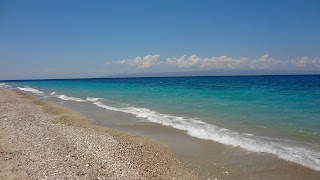A lot of people have been asking me what a typical day is like here. It goes something like this.
5:30--Wake up to sound of barking dogs. Fight the urge to go outside and throttle them. Wonder about my violent sentiments seeing as I consider myself a dog person. Turn over and go back to sleep.
6:15--Slowly start the getting up and getting ready for work routine that involves negotiating the sharing of the bathroom, the kitchen, etc..with my 10 roomies, followed by eating a hearty breakfast prepared by the cook that is waiting for us on the terrasse.
7:00--Pile into the cars waiting to take us to the office. Bump along through shortcuts and traffic jams, observing life on the streets of port-au-prince through the window. Sometimes listening to my ipod, sometimes talking about Haiti with the driver, sometimes debriefing work or planning weekend adventures with my fellow passengers.
8:00--Arrive at the office. Wash hands with chlorine (the first of many times this happens in a day, which means you constantly smell like a swimming pool, but feel protected from cholera). Enter the office to a flurry of activity as everyone prepares for the day ahead. Lots of greetings all around--two kisses for the french, and a 'Komon ou ye' for the Haitians, to which the appropriate response is 'en forme'.
9:00-5:00--The work day. Either at the office, an old house that HI has rented and turned into office space, where everyone is working away at their computers, or engaged in meetings--your typical office setting really (only much hotter with no air conditioning and a constant flow of coffee, which i think is the French influence). Or in the field, which essentially means different neighbourhoods in port-au-prince. When this is the case, we drive from one beneficiaries house to the next, which can sometimes take hours because of the traffic, and the fact that addresses are assigned somewhat arbitrarily. Finding a house usually means stopping 5-10 times to ask people for directions, but luckily somebody always knows somebody, who knows somebody else, who knows the person we are looking for, and the process is always very entertaining. We eventually get to our destination do do our evaluations which is the best part as that's when we really get to know the families, how they live, what their lives are like, etc...
5:00--Everyone meets back at the office. Generally people are either hot and cranky or excited and exhilarated depending on their activities of the day. Then begins the process of bargaining for a place in the car for the ride home.
7:00--Usually arrive home by this time, although sometimes it can be later depending once again on the traffic. Gather remaining energy and do some kind of exercise to make up for the fact that most of the day is spent sitting.
8:00--Eat dinner left by cook in the fridge and re-heated in the microwave, or maybe go out for a meal at one of the MANY nice restaurants. Hang with roomies, watch a movie, read, work, or catch up on emails, etc....
10:00--Start the getting ready for bed process (5:30 comes early). Bug net. check. Fan. check. Head lamp. Check.
11:00--Good night!
 |
| The breakfast table |
 |
| The drive to work |
 |
| My colleague at the office |
 |
| Street scene |



















































